Promoting Equality, Diversity, and Inclusion in Childcare TDA 3.6
VerifiedAdded on 2021/02/17
|5
|1480
|206
Homework Assignment
AI Summary
This assignment addresses the promotion of equality, diversity, and inclusion in childcare settings, covering key aspects such as relevant legislation (Race Relations Act, Human Rights Act, Equality Act, Sex Discrimination Act), the importance of children's rights, and the benefits of cultural diversity. It explores how children and young people experience prejudice and discrimination, analyzes the impact of such experiences, and evaluates how one's own attitudes and behaviors can affect interactions with children. The assignment also examines practical ways to promote anti-discrimination, challenges in addressing discrimination, and the concept of inclusive practices. References to supporting literature are also included.
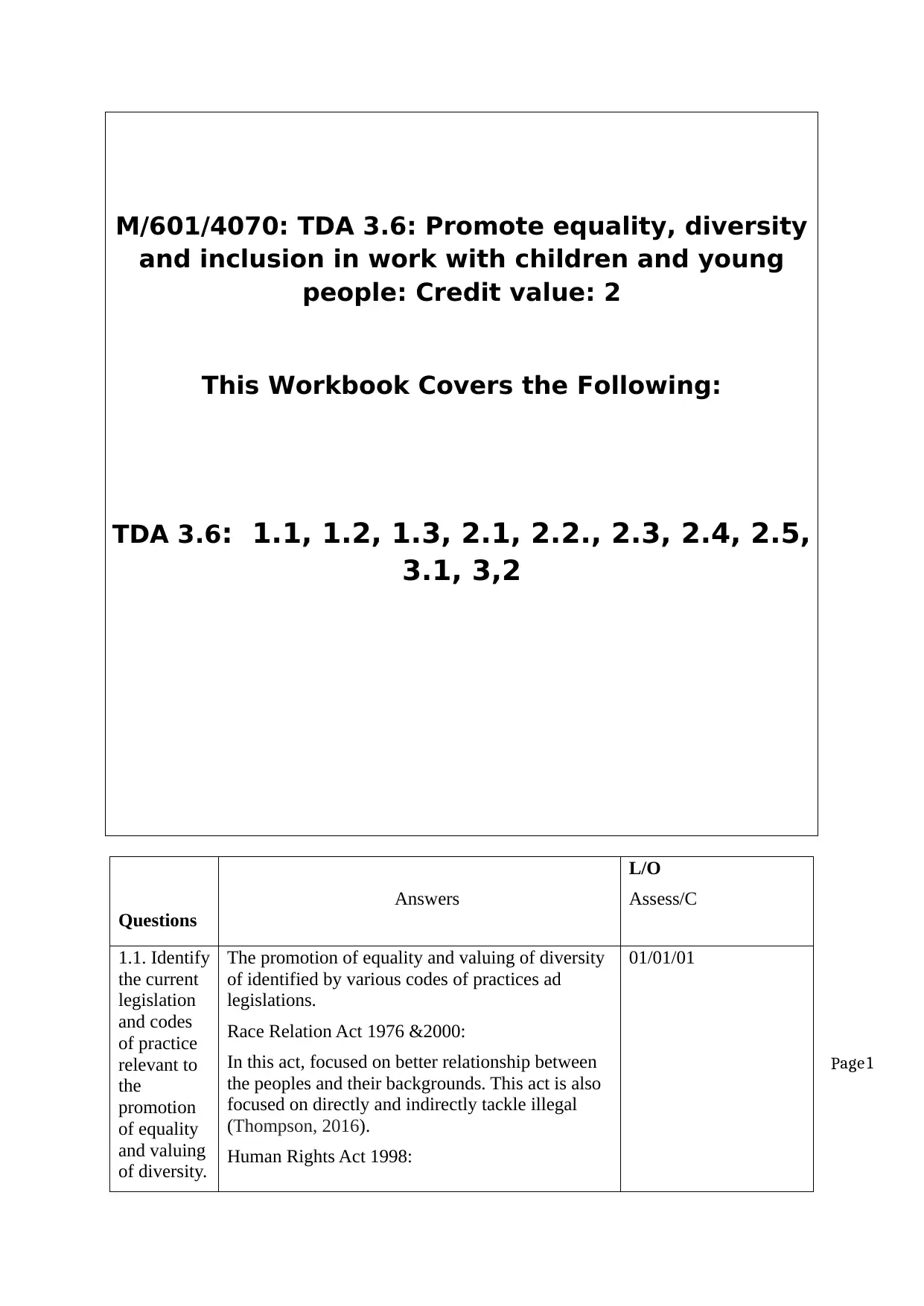
Page1
M/601/4070: TDA 3.6: Promote equality, diversity
and inclusion in work with children and young
people: Credit value: 2
This Workbook Covers the Following:
TDA 3.6: 1.1, 1.2, 1.3, 2.1, 2.2., 2.3, 2.4, 2.5,
3.1, 3,2
Questions
Answers
L/O
Assess/C
1.1. Identify
the current
legislation
and codes
of practice
relevant to
the
promotion
of equality
and valuing
of diversity.
The promotion of equality and valuing of diversity
of identified by various codes of practices ad
legislations.
Race Relation Act 1976 &2000:
In this act, focused on better relationship between
the peoples and their backgrounds. This act is also
focused on directly and indirectly tackle illegal
(Thompson, 2016).
Human Rights Act 1998:
01/01/01
M/601/4070: TDA 3.6: Promote equality, diversity
and inclusion in work with children and young
people: Credit value: 2
This Workbook Covers the Following:
TDA 3.6: 1.1, 1.2, 1.3, 2.1, 2.2., 2.3, 2.4, 2.5,
3.1, 3,2
Questions
Answers
L/O
Assess/C
1.1. Identify
the current
legislation
and codes
of practice
relevant to
the
promotion
of equality
and valuing
of diversity.
The promotion of equality and valuing of diversity
of identified by various codes of practices ad
legislations.
Race Relation Act 1976 &2000:
In this act, focused on better relationship between
the peoples and their backgrounds. This act is also
focused on directly and indirectly tackle illegal
(Thompson, 2016).
Human Rights Act 1998:
01/01/01
Paraphrase This Document
Need a fresh take? Get an instant paraphrase of this document with our AI Paraphraser
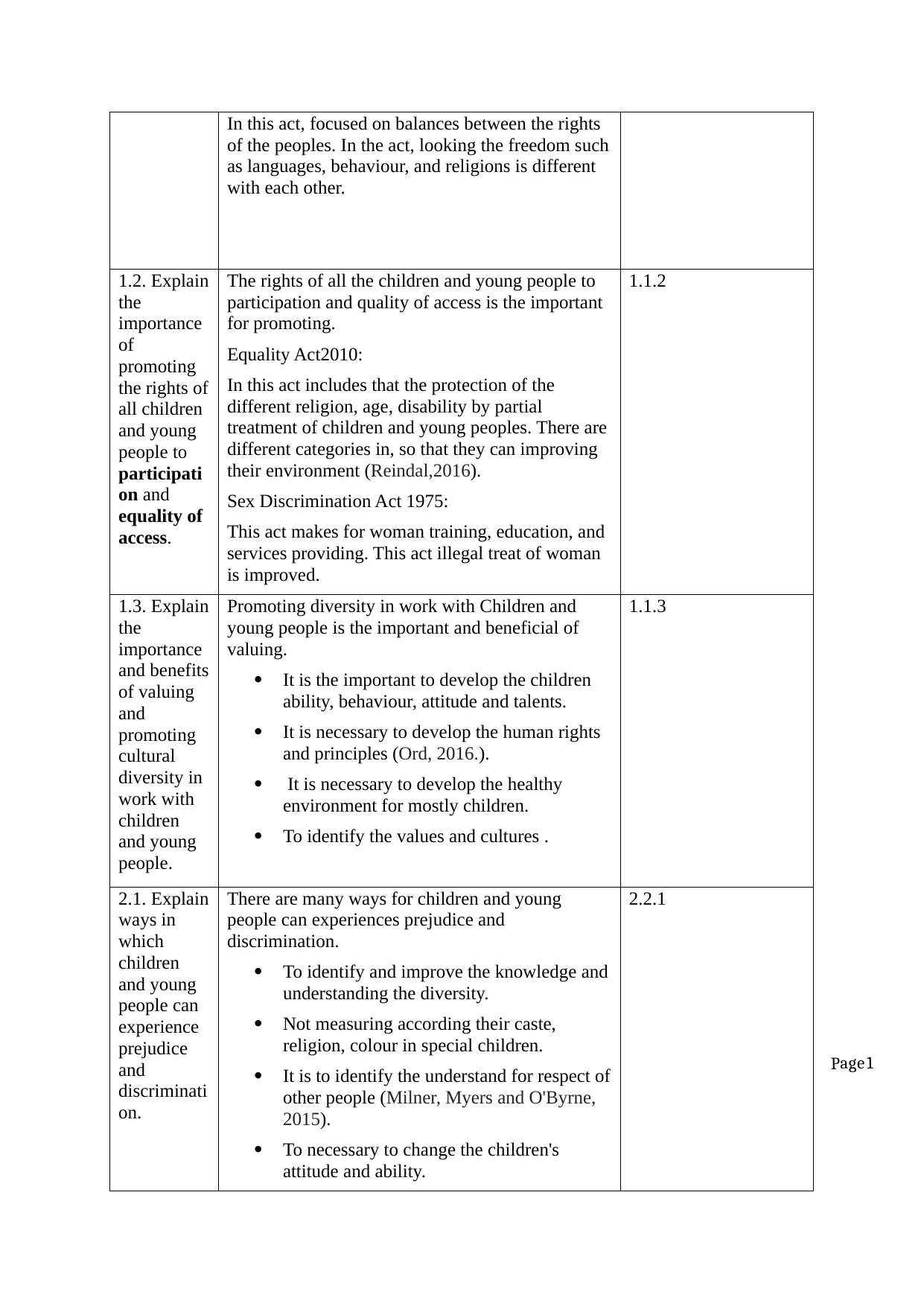
Page1
In this act, focused on balances between the rights
of the peoples. In the act, looking the freedom such
as languages, behaviour, and religions is different
with each other.
1.2. Explain
the
importance
of
promoting
the rights of
all children
and young
people to
participati
on and
equality of
access.
The rights of all the children and young people to
participation and quality of access is the important
for promoting.
Equality Act2010:
In this act includes that the protection of the
different religion, age, disability by partial
treatment of children and young peoples. There are
different categories in, so that they can improving
their environment (Reindal,2016).
Sex Discrimination Act 1975:
This act makes for woman training, education, and
services providing. This act illegal treat of woman
is improved.
1.1.2
1.3. Explain
the
importance
and benefits
of valuing
and
promoting
cultural
diversity in
work with
children
and young
people.
Promoting diversity in work with Children and
young people is the important and beneficial of
valuing.
It is the important to develop the children
ability, behaviour, attitude and talents.
It is necessary to develop the human rights
and principles (Ord, 2016.).
It is necessary to develop the healthy
environment for mostly children.
To identify the values and cultures .
1.1.3
2.1. Explain
ways in
which
children
and young
people can
experience
prejudice
and
discriminati
on.
There are many ways for children and young
people can experiences prejudice and
discrimination.
To identify and improve the knowledge and
understanding the diversity.
Not measuring according their caste,
religion, colour in special children.
It is to identify the understand for respect of
other people (Milner, Myers and O'Byrne,
2015).
To necessary to change the children's
attitude and ability.
2.2.1
In this act, focused on balances between the rights
of the peoples. In the act, looking the freedom such
as languages, behaviour, and religions is different
with each other.
1.2. Explain
the
importance
of
promoting
the rights of
all children
and young
people to
participati
on and
equality of
access.
The rights of all the children and young people to
participation and quality of access is the important
for promoting.
Equality Act2010:
In this act includes that the protection of the
different religion, age, disability by partial
treatment of children and young peoples. There are
different categories in, so that they can improving
their environment (Reindal,2016).
Sex Discrimination Act 1975:
This act makes for woman training, education, and
services providing. This act illegal treat of woman
is improved.
1.1.2
1.3. Explain
the
importance
and benefits
of valuing
and
promoting
cultural
diversity in
work with
children
and young
people.
Promoting diversity in work with Children and
young people is the important and beneficial of
valuing.
It is the important to develop the children
ability, behaviour, attitude and talents.
It is necessary to develop the human rights
and principles (Ord, 2016.).
It is necessary to develop the healthy
environment for mostly children.
To identify the values and cultures .
1.1.3
2.1. Explain
ways in
which
children
and young
people can
experience
prejudice
and
discriminati
on.
There are many ways for children and young
people can experiences prejudice and
discrimination.
To identify and improve the knowledge and
understanding the diversity.
Not measuring according their caste,
religion, colour in special children.
It is to identify the understand for respect of
other people (Milner, Myers and O'Byrne,
2015).
To necessary to change the children's
attitude and ability.
2.2.1
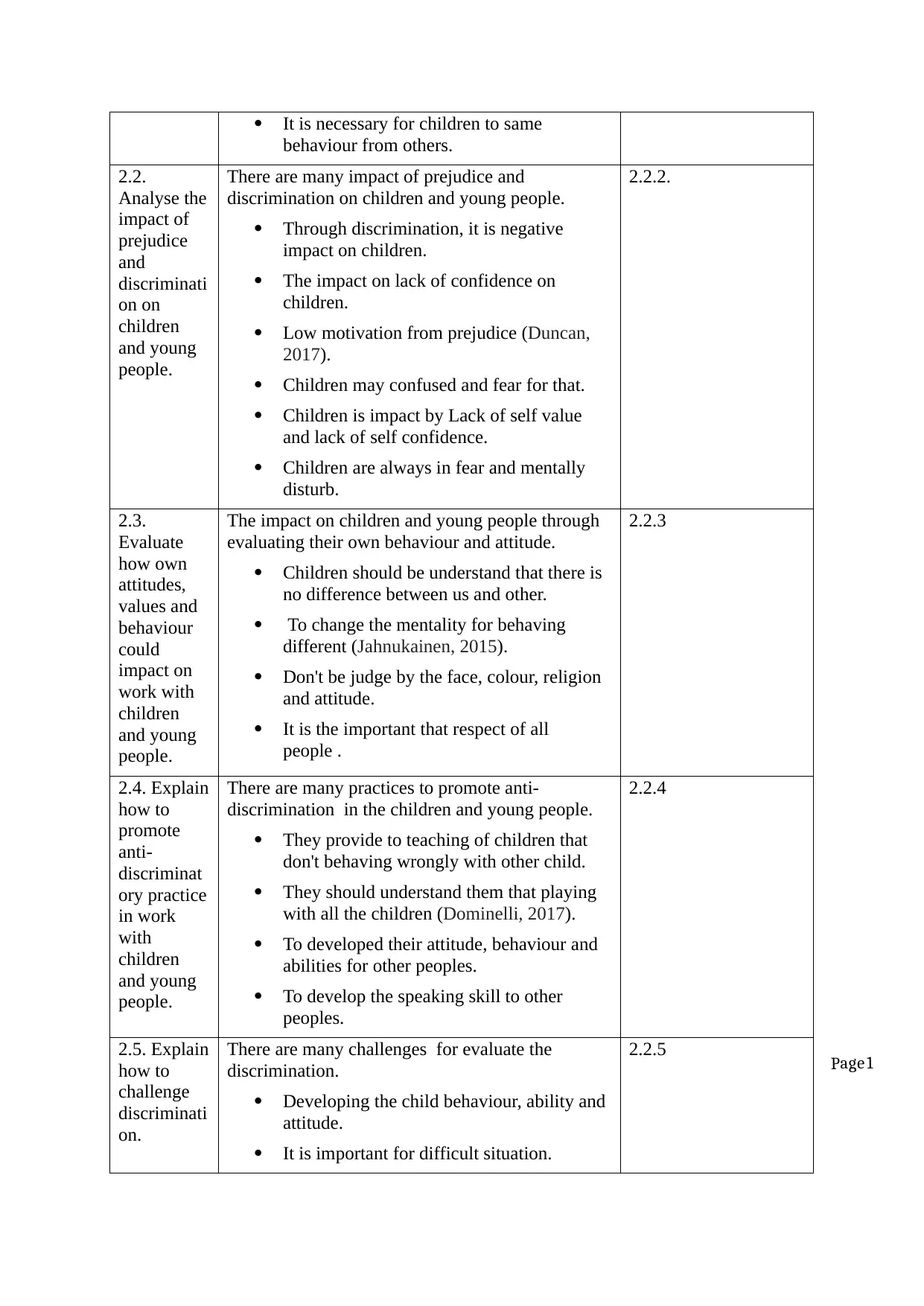
Page1
It is necessary for children to same
behaviour from others.
2.2.
Analyse the
impact of
prejudice
and
discriminati
on on
children
and young
people.
There are many impact of prejudice and
discrimination on children and young people.
Through discrimination, it is negative
impact on children.
The impact on lack of confidence on
children.
Low motivation from prejudice (Duncan,
2017).
Children may confused and fear for that.
Children is impact by Lack of self value
and lack of self confidence.
Children are always in fear and mentally
disturb.
2.2.2.
2.3.
Evaluate
how own
attitudes,
values and
behaviour
could
impact on
work with
children
and young
people.
The impact on children and young people through
evaluating their own behaviour and attitude.
Children should be understand that there is
no difference between us and other.
To change the mentality for behaving
different (Jahnukainen, 2015).
Don't be judge by the face, colour, religion
and attitude.
It is the important that respect of all
people .
2.2.3
2.4. Explain
how to
promote
anti-
discriminat
ory practice
in work
with
children
and young
people.
There are many practices to promote anti-
discrimination in the children and young people.
They provide to teaching of children that
don't behaving wrongly with other child.
They should understand them that playing
with all the children (Dominelli, 2017).
To developed their attitude, behaviour and
abilities for other peoples.
To develop the speaking skill to other
peoples.
2.2.4
2.5. Explain
how to
challenge
discriminati
on.
There are many challenges for evaluate the
discrimination.
Developing the child behaviour, ability and
attitude.
It is important for difficult situation.
2.2.5
It is necessary for children to same
behaviour from others.
2.2.
Analyse the
impact of
prejudice
and
discriminati
on on
children
and young
people.
There are many impact of prejudice and
discrimination on children and young people.
Through discrimination, it is negative
impact on children.
The impact on lack of confidence on
children.
Low motivation from prejudice (Duncan,
2017).
Children may confused and fear for that.
Children is impact by Lack of self value
and lack of self confidence.
Children are always in fear and mentally
disturb.
2.2.2.
2.3.
Evaluate
how own
attitudes,
values and
behaviour
could
impact on
work with
children
and young
people.
The impact on children and young people through
evaluating their own behaviour and attitude.
Children should be understand that there is
no difference between us and other.
To change the mentality for behaving
different (Jahnukainen, 2015).
Don't be judge by the face, colour, religion
and attitude.
It is the important that respect of all
people .
2.2.3
2.4. Explain
how to
promote
anti-
discriminat
ory practice
in work
with
children
and young
people.
There are many practices to promote anti-
discrimination in the children and young people.
They provide to teaching of children that
don't behaving wrongly with other child.
They should understand them that playing
with all the children (Dominelli, 2017).
To developed their attitude, behaviour and
abilities for other peoples.
To develop the speaking skill to other
peoples.
2.2.4
2.5. Explain
how to
challenge
discriminati
on.
There are many challenges for evaluate the
discrimination.
Developing the child behaviour, ability and
attitude.
It is important for difficult situation.
2.2.5
⊘ This is a preview!⊘
Do you want full access?
Subscribe today to unlock all pages.

Trusted by 1+ million students worldwide
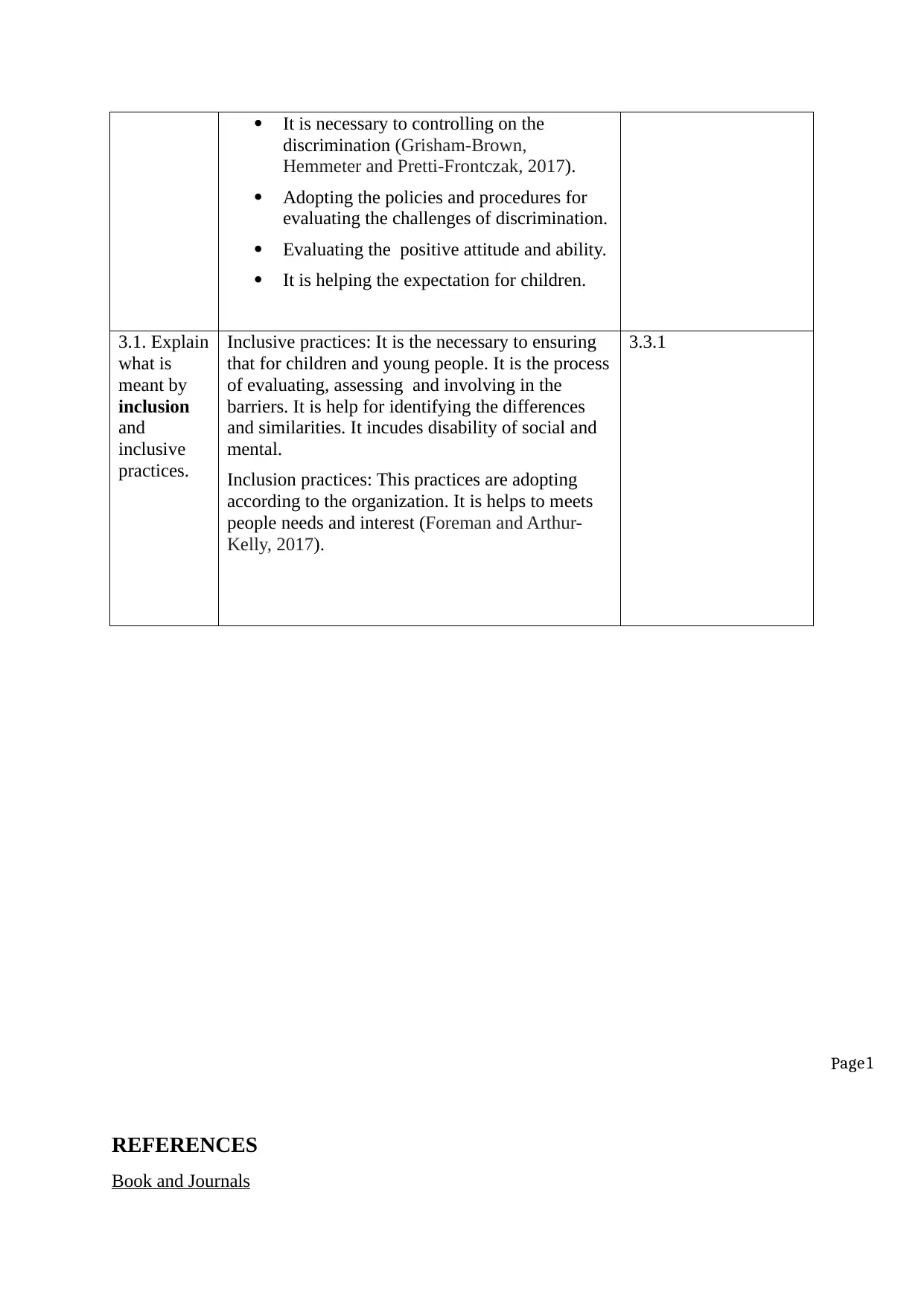
Page1
It is necessary to controlling on the
discrimination (Grisham-Brown,
Hemmeter and Pretti-Frontczak, 2017).
Adopting the policies and procedures for
evaluating the challenges of discrimination.
Evaluating the positive attitude and ability.
It is helping the expectation for children.
3.1. Explain
what is
meant by
inclusion
and
inclusive
practices.
Inclusive practices: It is the necessary to ensuring
that for children and young people. It is the process
of evaluating, assessing and involving in the
barriers. It is help for identifying the differences
and similarities. It incudes disability of social and
mental.
Inclusion practices: This practices are adopting
according to the organization. It is helps to meets
people needs and interest (Foreman and Arthur-
Kelly, 2017).
3.3.1
REFERENCES
Book and Journals
It is necessary to controlling on the
discrimination (Grisham-Brown,
Hemmeter and Pretti-Frontczak, 2017).
Adopting the policies and procedures for
evaluating the challenges of discrimination.
Evaluating the positive attitude and ability.
It is helping the expectation for children.
3.1. Explain
what is
meant by
inclusion
and
inclusive
practices.
Inclusive practices: It is the necessary to ensuring
that for children and young people. It is the process
of evaluating, assessing and involving in the
barriers. It is help for identifying the differences
and similarities. It incudes disability of social and
mental.
Inclusion practices: This practices are adopting
according to the organization. It is helps to meets
people needs and interest (Foreman and Arthur-
Kelly, 2017).
3.3.1
REFERENCES
Book and Journals
Paraphrase This Document
Need a fresh take? Get an instant paraphrase of this document with our AI Paraphraser
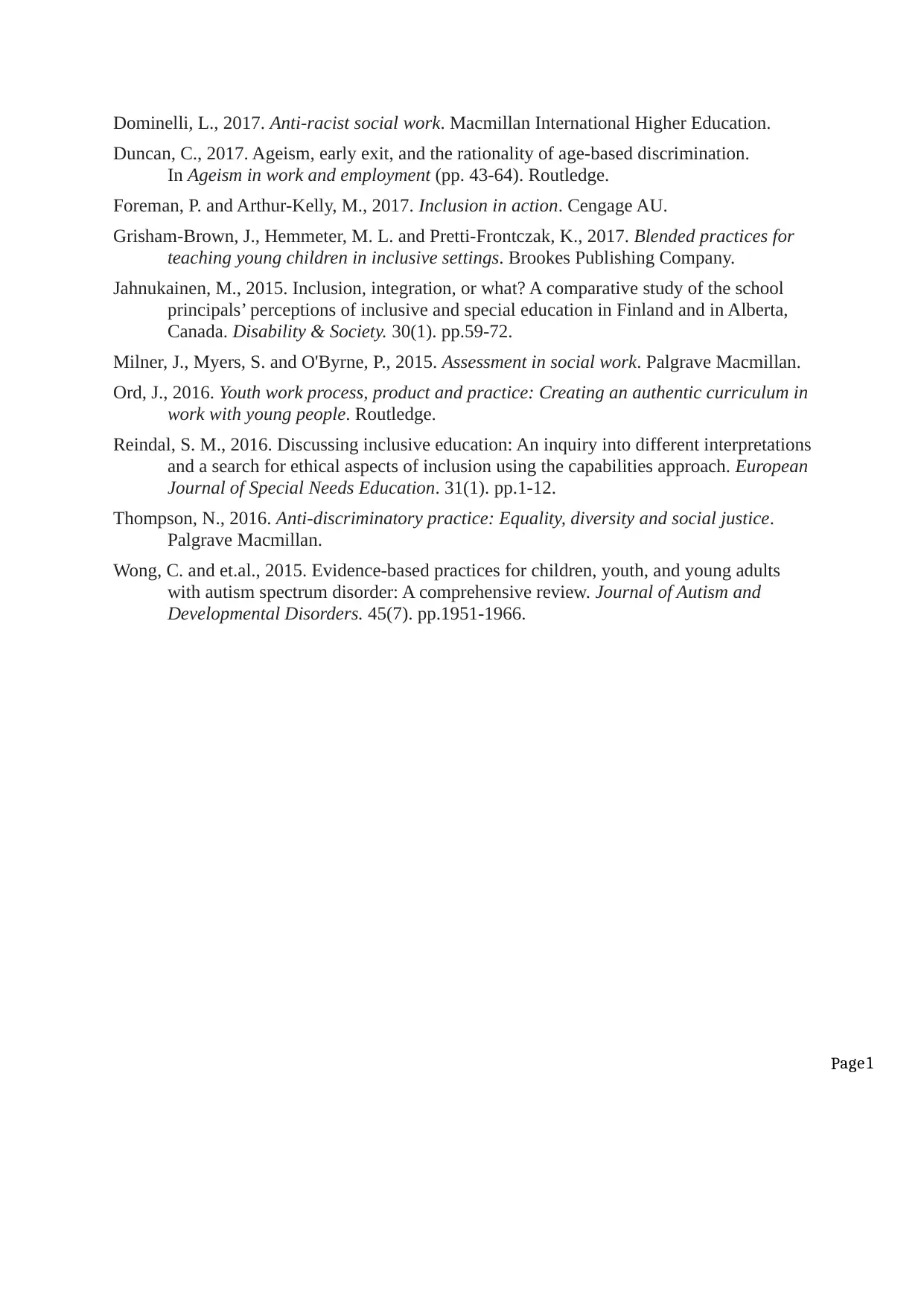
Page1
Dominelli, L., 2017. Anti-racist social work. Macmillan International Higher Education.
Duncan, C., 2017. Ageism, early exit, and the rationality of age-based discrimination.
In Ageism in work and employment (pp. 43-64). Routledge.
Foreman, P. and Arthur-Kelly, M., 2017. Inclusion in action. Cengage AU.
Grisham-Brown, J., Hemmeter, M. L. and Pretti-Frontczak, K., 2017. Blended practices for
teaching young children in inclusive settings. Brookes Publishing Company.
Jahnukainen, M., 2015. Inclusion, integration, or what? A comparative study of the school
principals’ perceptions of inclusive and special education in Finland and in Alberta,
Canada. Disability & Society. 30(1). pp.59-72.
Milner, J., Myers, S. and O'Byrne, P., 2015. Assessment in social work. Palgrave Macmillan.
Ord, J., 2016. Youth work process, product and practice: Creating an authentic curriculum in
work with young people. Routledge.
Reindal, S. M., 2016. Discussing inclusive education: An inquiry into different interpretations
and a search for ethical aspects of inclusion using the capabilities approach. European
Journal of Special Needs Education. 31(1). pp.1-12.
Thompson, N., 2016. Anti-discriminatory practice: Equality, diversity and social justice.
Palgrave Macmillan.
Wong, C. and et.al., 2015. Evidence-based practices for children, youth, and young adults
with autism spectrum disorder: A comprehensive review. Journal of Autism and
Developmental Disorders. 45(7). pp.1951-1966.
Dominelli, L., 2017. Anti-racist social work. Macmillan International Higher Education.
Duncan, C., 2017. Ageism, early exit, and the rationality of age-based discrimination.
In Ageism in work and employment (pp. 43-64). Routledge.
Foreman, P. and Arthur-Kelly, M., 2017. Inclusion in action. Cengage AU.
Grisham-Brown, J., Hemmeter, M. L. and Pretti-Frontczak, K., 2017. Blended practices for
teaching young children in inclusive settings. Brookes Publishing Company.
Jahnukainen, M., 2015. Inclusion, integration, or what? A comparative study of the school
principals’ perceptions of inclusive and special education in Finland and in Alberta,
Canada. Disability & Society. 30(1). pp.59-72.
Milner, J., Myers, S. and O'Byrne, P., 2015. Assessment in social work. Palgrave Macmillan.
Ord, J., 2016. Youth work process, product and practice: Creating an authentic curriculum in
work with young people. Routledge.
Reindal, S. M., 2016. Discussing inclusive education: An inquiry into different interpretations
and a search for ethical aspects of inclusion using the capabilities approach. European
Journal of Special Needs Education. 31(1). pp.1-12.
Thompson, N., 2016. Anti-discriminatory practice: Equality, diversity and social justice.
Palgrave Macmillan.
Wong, C. and et.al., 2015. Evidence-based practices for children, youth, and young adults
with autism spectrum disorder: A comprehensive review. Journal of Autism and
Developmental Disorders. 45(7). pp.1951-1966.
1 out of 5
Related Documents
Your All-in-One AI-Powered Toolkit for Academic Success.
+13062052269
info@desklib.com
Available 24*7 on WhatsApp / Email
![[object Object]](/_next/static/media/star-bottom.7253800d.svg)
Unlock your academic potential
Copyright © 2020–2025 A2Z Services. All Rights Reserved. Developed and managed by ZUCOL.





